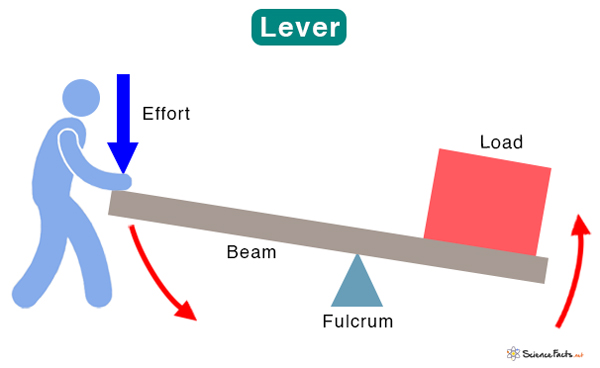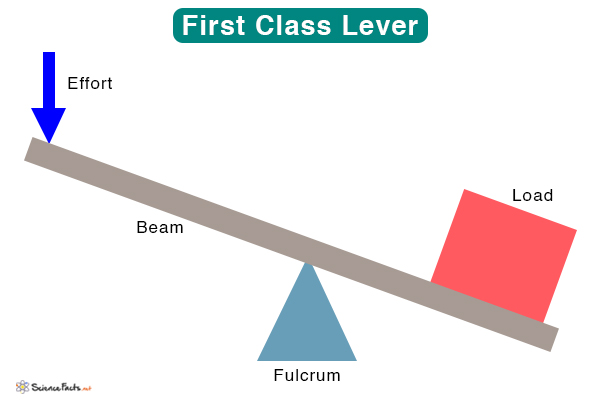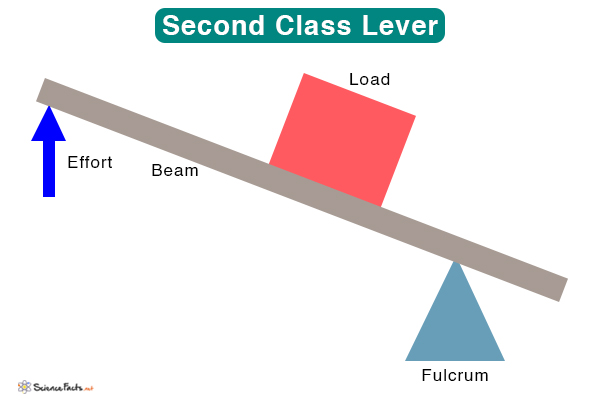Who Invented the Lever Greek mathematician Archimedes was the first to develop lever principles in 260 B.C.
Parts of a Lever
How Does a Lever Work
Types of Levers
Applications and Uses of Lever
The beam rotates about the pivot point. A torque is necessary to rotate the beam and lift the object. The basic principle is that the applied torque manifests at the load.
Mechanical Advantage of a Lever
The mechanical advantage measures how much a lever can multiply the force applied to lift or move the load. The relative positions of the fulcrum, load, and effort determine the mechanical advantage value. It is mathematically given by the ratio of the load and effort and proven by the Greek mathematician and physicist Archimedes. Mechanical Advantage = Load/Effort This formula can also be written as, IMA = Effort arm/ Load arm Where, IMA = Ideal mechanical advantage Effort arm = Distance from effort to fulcrum Load arm = Distance from load to fulcrum Suppose the distance from the effort to the fulcrum is greater than that from the load. In that case, the mechanical advantage is greater than one. In other words, the further the effort is from the fulcrum, the easier it is to displace the load since a small effort is required. Therefore, placing the fulcrum close to the load is advantageous to minimize the effort. Levers are designed such that their mechanical advantage is greater than one, which makes them ideal simple machines.
1. First Class
Also known as Class 1 or 1st class lever, the load is at one end of the beam, and the effort is at the other end. The fulcrum is between the load and effort. Depending upon the position of the fulcrum, the effort can be high or low. If the fulcrum is closer to the load than the effort, the effort is low. The effort is high if the fulcrum is closer to the effort than the load. Examples – Car jack, crowbar, seesaw, boat oar, scissors, pliers, claw hammer, bolt cutter, and wire stripper
2. Second Class
Also known as Class 2 or 2nd class lever, the fulcrum is at one end of the beam, and the effort is at the other end. The load is located between the fulcrum and effort. The position of the load affects the effort. If the load is closer to the fulcrum than the effort, the effort is low. The effort is high if the load is closer to the effort than the fulcrum. Examples – Bottle opener, wheelbarrow, nutcracker, brake pedal, and conventional door
3. Third Class
Also known as Class 3 or 3rd class lever, the fulcrum is at one end of the beam, and the load is at the other end. The effort is located between the fulcrum and load. The effort depends upon its position. The effort is high if it is closer to the load than the fulcrum. The effort is high if it is closer to the fulcrum than the load. Examples – Garden shovel, rake, hockey stick, tweezers, tongs, fishing rod, and hammer
Lifting and moving objects using a wheelbarrowRemoving nails using a claw hammerLifting small particles using a tweezerCutting or separating materials using scissorsStripping wires using pliers or wire cutter
Besides, many parts of the human body function like a lever. The joints behave like a fulcrum, and the bones act as a beam. The following image shows some examples of levers used in daily life.





